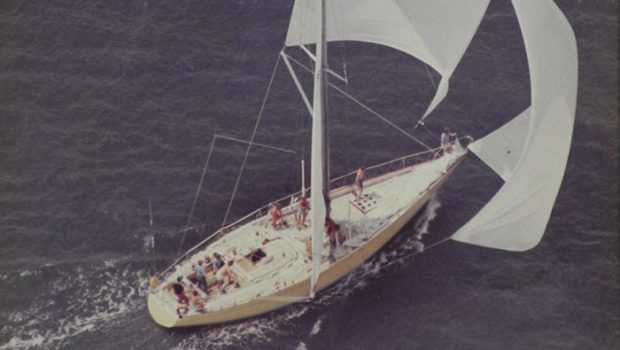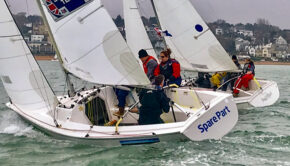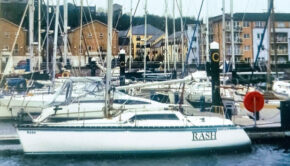Overboard: Stories from off the boat
Published on August 19th, 2019
Falling overboard can occur unexpectedly and end tragically. Staying onboard is always a priority, but even the most experienced can find themselves off the boat. Nick Kennedy shares his experience.
The following is an account of the MOB incident when we were crossing from Newport, RI to Dakar, Senegal. As validated in discussion recently with three of us crew at Mystic Seaport (Steve White), the experience remains still vivid even if the intervening 40+ years may have blurred some details.
In September 1975, a crew of six set off from Newport, RI bound for Cape Town in the 55-foot Palmer Johnson built racing boat, Safari (former Dora III and smaller version of Dora IV/Tenacious). The objective was to arrive in time for the Cape Town to Rio de Janeiro Race.
In a bold act of management through expectation, Paul Adams (the owner) sent off his boat with a crew including five guys who had never done much blue water sailing – much less a transatlantic crossing. Our navigator Donald Elliott had circled the world the prior year with Huey Long’s Ondine. I remain admiring and indebted to Donald but am still not sure what the heck he was thinking.
Within a day of leaving Newport, we were set upon by a full gale and spent the next three days running before it with a triple-reefed main and a poled-out jib top/storm jib. The storm stayed with us and the waves continued to build. Soon we were boiling in breaking crests, surfing down the steep slopes and then becalmed in the troughs until the next wave lifted the stern and we started all over again.
Night watches were toughest. We were enveloped in darkness with no stars and only the illuminated Windex for reference. I went on to do four more transatlantic crossings, 20 Bermuda Races, and races all over the world but have never seen seas to match the ones we saw.
I have a photo of Mike Toppa and me at the wheel with just our heads at the bottom of the frame with a wall of water behind us and only a thin sliver of sky at the top of the frame (portrait-oriented photo too).
On the fifth day, the sun came out and the winds abated. We were jibing with the same storm sails up and the boat was flopping around under canvased in the now smaller but still big seas. I was running the new vang back to a block on the port side when the boat shifted hard to starboard and the lifeline caught me in the back of the legs. The next instant I was over the side and I was watching the stern slip away down the next wave.
On the boat, everyone was on deck and one guy took the spotter position. First life ring and flag buoy were thrown and then followed after a space (to provide a range) by the second life ring. Lee Killingworth put the boat on a beam reach – to enable a reciprocal return course. Donald Elliott dove for the Nav table and noted the mileage on the log and started counting tenths as the boat sailed away from the MOB point. (No GPS or even Loran available.)
In the water, I was struggling to swim with my full set of foul weather gear and weighed down by my water-filled boots. I also was tumbling in some of the crests – getting disoriented and swallowing water. The boat immediately disappeared from view and I never saw the life rings. Finally, I got one boot and my top off but then had to devote all energies to keeping my head above water.
When the boat was squared away and tacked back, Donald started counting off the tenths back to the MOB point. At the final tenth, he called out and went on deck where there was no man to be seen. At that point, the Holy __ /what do we do if__ thoughts started to circulate.
Before starting a grid pattern search, the crew carried on the same course for a bit further with no sign of either the second life ring or me. As Donald tells it, they finally saw what they initially thought was a floating coconut but which turned out to be my head.
The boat was positioned to windward of me and one of the 1″ Sampson Braid jib sheets with a bowline was thrown to me. The other end went through a block to a grinder drum. I got the loop around my shoulders, and as the boat rolled toward me, the guys took up the slack on the drum.
As several tons of boat rolled back, the line took up and I was snatched out of the water toward the boat like a wounded flying fish. At that point, my other boot popped off, almost taking my foot with it.
The short conclusion to this story is that I owe my life to Donald Elliott, Lee Killingworth, Mike Toppa, Steve white, and Fred Fairfield – late and much missed. Their seamanship, excellence, and perseverance cannot be overstated. Also, these are great guys of exceptional talent, natural leadership, humor, and generosity. John Kjorlien, who joined us in Dakar, is a star also.
The longer conclusion, for which there is not space here, must include lessons learned and acknowledgement of errors on my part. In general, as a crew you have a moral responsibility to stay the heck on the boat.
While not always possible, and we have lost better sailors than I to uncontrolled and tragic circumstances, but within the areas you can control you must take take the necessary precautions to minimize risk such as always wearing a harness offshore. I should not have removed my life harness just because the storm had passed. Stay low when moving about the boat in a seaway, keep knees below the lifelines, etc.
——————–
Scuttlebutt wants to feature your overboard experience. Send to editor@sailingscuttlebutt.com.









 We’ll keep your information safe.
We’ll keep your information safe.